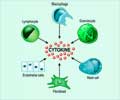Using multiple tactics to boost both innate and adaptive immunity in mice, scientists at Scripps Research Department of Immunology have successfully enhanced their body's ability to fight cancer.
Scientists at Scripps Research Department of Immunology have successfully enhanced the body's ability to fight cancer in mice by using multiple tactics to boost both innate and adaptive immunity.
The researchers hope that their work may pave the way for developing new human immunotherapy."The problem with cancer is that it becomes part of what the immune system identifies as 'self' and there are ways the body learns to tolerate 'self' to prevent immune attack. Hitting it with these new tools basically gets the immune system to pay attention to the cancer, and go after it," said the study's senior investigator, Dr. Linda Sherman.
She added: "What is needed is effective and non-toxic immunotherapy for cancer patients, and we believe this work provides a foundation for that. The concepts we have shown are directly translatable to human therapy."
Scientists used two different strategies for their study - the first one involved forcing T cells, the killer cells of immune system, to become active and grow in the presence of tumour "antigens".
Antigens are the proteins on the outside of cancer cells that can stimulate an immune response. When T cells recognize the tumour antigens, their response to them becomes chronically weak because they are 'self'.
"We have been working for years to find ways to coax these so-called low affinity T cells to work better," said Sherman.
Earlier it was found that when IL-2 was combined with a specific type of IL-2 antibody, it enabled the complex to bind better to activated T cells and resulted in the production of a more robust T cell response.
Thus, for triggering an immune reaction, the researchers primed T cells with this complex, which after binding with T cells, grow and mature and deliver a signal to release cytotoxic granules that enter tumour cells and promote apoptosis, or cell death.
"A number of nice things begin to happen. T cell growth is promoted as well as their killing function. There is a lot of good activity," said Sherman.
But, the moment the IL-2 complex is withdrawn the T cells die quickly.
The second strategy was to also deliver an agent, called poly(l:C), that keeps T cells surviving longer. Poly (l:C) also enhances the killing power of the T cells by stimulating the innate immune system, which provides an immediate defence against invaders.
"It is this trick of really stimulating T cell proliferation and killing functions, and then keeping the T cells alive, that provides the double whammy. The T cells are hitting all their bases, and that is when we see the killing of tumors," said Sherman.
The scientists tested the system in mice that spontaneously develop tumours by delivering tumour antigen, the IL2 complex, and poly(l:C) together at the same time. They showed that the strategy was quite safe and effective.
The study is published in an early edition issue of the Proceedings of the National Academy of Sciences (PNAS).
Source-ANI
RAS/SK
 MEDINDIA
MEDINDIA




 Email
Email






